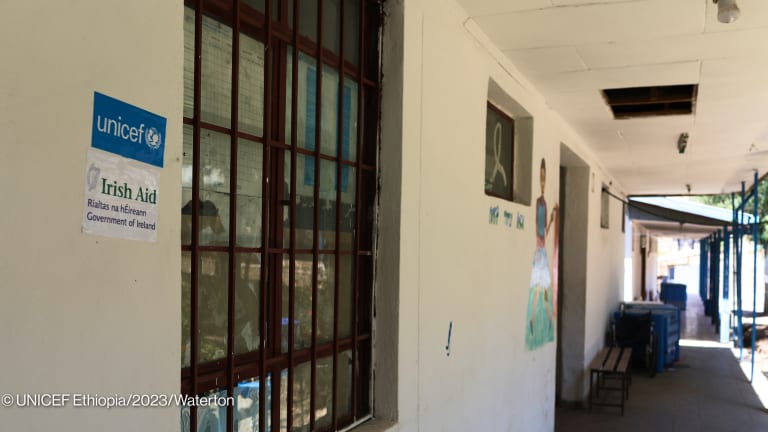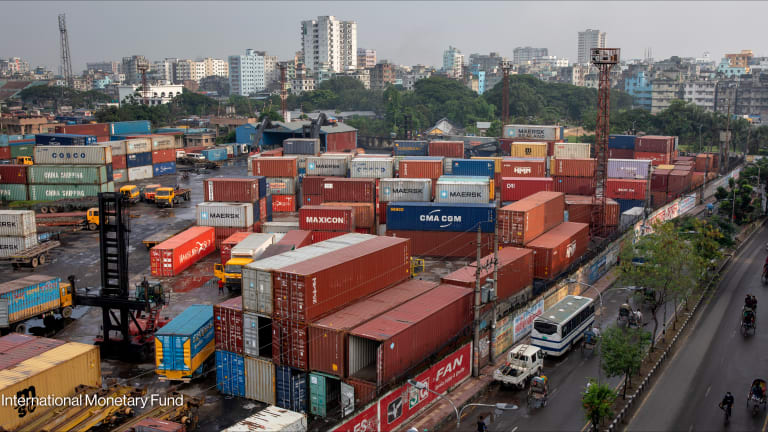Top 10 OECD-DAC donors: A primer
On Wednesday, preliminary data revealed that net ODA from the OECD’s Development Assistance Committee, the donor grouping for industrialized countries, reached near record highs in 2014. Devex takes a closer look at the strategies and priorities of the 10 biggest OECD-DAC donors.
Even as emerging donors gain clout in the foreign aid industry — the rise of the Asian Infrastructure Investment Bank is case in point — traditional donors remain, by far, the dominant source of development finance globally. On Wednesday, preliminary data from the Organization for Economic Cooperation and Development revealed that net total official development assistance from the OECD Development Assistance Committee, the donor grouping for industrialized countries, reached $135.2 billion in 2014, just above its record high of $135.1 billion in 2013. By comparison, Devex estimates that aid flows from the BRICS economies — Brazil, Russia, India, China, South Africa — likely did not exceed $10 billion in 2013. (Stay tuned to Devex for our exclusive report on emerging donors later this quarter). As Devex just reported, while OECD-DAC aid flows to the world’s poorest countries did fall 16 percent to $25 billion in 2014, donors’ forward-spending plans augur a sharper focus on least-developed countries through 2018. Among the 28 OECD-DAC member countries, 15 recorded increases in net ODA in 2014, while 13 saw cutbacks in their aid spending. Only five OECD-DAC member countries hit the U.N. target of allocating 0.7 percent of gross national income to ODA: the United Kingdom, Denmark, Norway, Luxembourg and Sweden. Below, Devex takes a closer look at the strategies and priorities of the 10 biggest OECD-DAC donors by total aid volume in 2014. Together, these 10 donors — only three of which already meet the U.N. target — accounted for nearly 84 percent of ODA flows from OECD-DAC donors that year. Strikingly, the United Arab Emirates, an emerging donor that reports aid flows to the OECD-DAC, would be ninth on this list if it were a full member of the committee. In fact, UAE recorded an ODA-to-GNI ratio of 1.17 percent in 2014, making the country the most generous aid provider for the second year in a row. 1. United States Principal implementing agency: U.S. Agency for International Development ODA budget (2014): $32.8 billion ↑ 2.3% ODA-to-GNI ratio (2014): 0.19 percent Top ODA recipient countries (2013): Afghanistan, Palestinian territories, Kenya, Syria (refugee assistance), Tanzania Since taking office in early 2009, the Obama administration has unveiled Feed the Future, Power Africa and the Global Climate Change Initiative as its marquee global development initiatives. Principally focused on sub-Saharan Africa, the U.S. President’s Emergency Plan for AIDS Relief, however, remains the single-largest funding envelope in the U.S. foreign aid budget. In a bid to promote local ownership and accountability, USAID has set a target of channeling 30 percent of its spending to local organizations by the end of the current U.S. fiscal year in September. 2. United Kingdom Principal implementing agency: U.K. Department for International Development ODA budget (2014): $19.4 billion ↑ 1.2% ODA-to-GNI ratio (2014): 0.71 percent Top ODA recipient countries (2013): Pakistan, Ethiopia, Bangladesh, India, Nigeria In March, the U.K. Parliament overwhelmingly passed a bill that enshrined into law the United Kingdom’s long-standing commitment to spend 0.7 percent of its GNI on ODA — proof positive of broad political backing for the U.K. aid program ahead of next month’s general elections. Keen to refocus U.K. aid on poorer countries, the Cameron government has announced plans to close DfID programs in middle-income countries, beginning in India and South Africa, by the end of this year. Health, education, economic development and governance are sector priorities for U.K. foreign aid. 3. Germany Principal implementing agencies: German Agency for International Cooperation or GIZ and KfW Entwicklungsbank ODA budget (2014): $16.2 billion ↑ 12% ODA-to-GNI ratio (2014): 0.41 percent Top ODA recipient countries (2013): Afghanistan, India, China, Syria (refugee assistance), Brazil In the 2013 coalition agreement that paved the way for the third Merkel government, education, health, rural development, good governance and sustainable development are spelled out as priorities for German foreign aid. While German foreign aid has long been heavily skewed toward middle-income countries, the 2013 coalition agreement also committed the third Merkel government to refocus its development engagement on poorer countries. GIZ, Germany’s technical cooperation agency, was only created in 2011 following a major organizational restructure. 4. France Principal implementing agency: French Development Agency ODA budget (2014): $10.4 billion ↓ 9.2% ODA-to-GNI ratio (2014): 0.36 percent Top ODA recipient countries (2013): Morocco, Myanmar, South Africa, Mexico, Colombia Last year, the French government’s first-ever law on development cooperation reaffirmed the French aid program’s sharp focus on the Mediterranean basin countries and sub-Saharan Africa. Economic development, security and governance, and environmental protection are sector priorities for French foreign aid. Amid intense fiscal pressures at home, France has pioneered the use of innovative financing mechanisms — including a financial transaction tax — to provide additional resources for its ODA budget. 5. Japan Principal implementing agency: Japan International Cooperation Agency ODA budget (2014): $9.2 billion ↓ 15.3% ODA-to-GNI ratio (2014): 0.19 percent Top ODA recipient countries (2013): Myanmar, Vietnam, Afghanistan, Iraq, India Economic infrastructure support, including for roads and bridges, is the mainstay of Japan’s foreign aid, which is principally channeled toward Asia-Pacific. Keen to counter China’s rising influence in Africa, in 2013, Japanese Prime Minister Shinzo Abe announced a five-year, $14 billion ODA boost to the continent. The Abe administration has recently unveiled a new foreign aid charter permitting Japan to extend noncombat assistance to foreign military troops — part of its efforts to more closely link Japan’s development agenda to the country’s strategic interests. 6. Sweden Principal implementing agency: Swedish International Development Cooperation Agency ODA budget (2014): $6.2 billion ↑ 11% ODA-to-GNI ratio (2014): 1.1 percent Top ODA recipient countries (2013): Mozambique, Afghanistan, Tanzania, Democratic Republic of the Congo, Kenya Recording the highest ODA-to-GNI ratio of any OECD-DAC member, Sweden targets its foreign aid toward poverty reduction in addition to three thematic priorities: democracy and human rights, environment and climate change, and gender equality. In a bid to focus its aid spending on fewer, lower-income countries, Sweden phased out bilateral cooperation with seven middle-income countries in 2013. The Swedish government’s 2014 aid policy framework identified women and girls in poor countries and people living under oppression as the two main beneficiaries of Swedish aid. 7. Netherlands Principal implementing agency: Ministry of Foreign Affairs ODA budget (2014): $5.6 billion ↑ 1.6% ODA-to-GNI ratio (2014): 0.64 percent Top ODA recipient countries (2013): Afghanistan, Ethiopia, Bangladesh, Mozambique, Mali Squeezed by austerity measures at home, the Netherlands saw its ODA dip below the 0.7 percent ODA-to-GNI target for the second consecutive year in 2014. Before 2013, the Netherlands had met the target consistently since 1975. In 2010, the Dutch government decided to halve Dutch aid’s partner countries from 33 to 15 and also phase out its support for basic health and education. Ten of Dutch aid’s 15 partner countries are in sub-Saharan Africa. Security and rule of law, water management, food security, and sexual and reproductive health and rights are sector priorities for Dutch aid. 8. Norway Principal implementing agency: Ministry of Foreign Affairs ODA budget (2014): $5 billion ↓ 4.3% ODA-to-GNI ratio (2014): 0.99 percent Top ODA recipient countries (2013): Brazil, Afghanistan, Palestinian territories, Malawi, Tanzania Consistently regarded as one of the world’s most generous aid donors, Norway has met the 0.7 percent ODA-to-GNI target every year since 1976. Heeding the recommendations of an OECD-DAC peer review of Norway’s aid program last year, the Norwegian government has set in motion plans to reduce the number of its aid recipient countries from 116 to 84. Seven of the 12 focus countries for Norwegian aid are located in sub-Saharan Africa. Education, humanitarian assistance, health, private sector development, climate change and human rights are sector priorities for Norwegian aid. 9. Australia Principal implementing agency: Department of Foreign Affairs and Trade ODA budget (2014): $4.2 billion ↓ 7.2% ODA-to-GNI ratio (2014): 0.27 percent Top ODA recipient countries (2013): Indonesia, Papua New Guinea, Solomon Islands, Vietnam, Philippines Shelving the previous Labor government’s pledge to hike ODA to 0.5 percent of GNI, the conservative Abbott government last year confirmed plans to focus Australia’s shrinking aid budget even further on Asia-Pacific. Canberra is in the process of phasing out aid to Latin America, but it will maintain a modest aid presence in sub-Saharan Africa. Considered its flagship sector, education is topmost priority for Australian aid. Shortly after taking office in September 2013, the Abbott government amalgamated the Australian Agency for International Development into DFAT. 10. Canada Principal implementing agency: Department of Foreign Affairs, Trade and Development ODA budget (2014): $4.2 billion ↓ 10.7% ODA-to-GNI ratio (2014): 0.24 percent Top ODA recipient countries (2013): Tanzania, Ethiopia, Afghanistan, Mozambique, Haiti Plagued by delays and underspending — the result, some analysts say, of “stealth” cuts by the conservative Harper government — Canada’s foreign aid program has five thematic priorities: food security, children and youth, sustainable economic growth, democracy, and stability and security. In a move that foreshadowed AusAID’s demise just months later, in March 2013, the Harper government amalgamated the Canadian International Development Agency into the country’s foreign ministry. Ten of Canadian aid’s 25 focus countries are in sub-Saharan Africa. Check out more funding trends analyses online, and subscribe to Money Matters to receive the latest contract award and shortlist announcements, and procurement and fundraising news.
Even as emerging donors gain clout in the foreign aid industry — the rise of the Asian Infrastructure Investment Bank is case in point — traditional donors remain, by far, the dominant source of development finance globally.
On Wednesday, preliminary data from the Organization for Economic Cooperation and Development revealed that net total official development assistance from the OECD Development Assistance Committee, the donor grouping for industrialized countries, reached $135.2 billion in 2014, just above its record high of $135.1 billion in 2013.
By comparison, Devex estimates that aid flows from the BRICS economies — Brazil, Russia, India, China, South Africa — likely did not exceed $10 billion in 2013. (Stay tuned to Devex for our exclusive report on emerging donors later this quarter).
This story is forDevex Promembers
Unlock this story now with a 15-day free trial of Devex Pro.
With a Devex Pro subscription you'll get access to deeper analysis and exclusive insights from our reporters and analysts.
Start my free trialRequest a group subscription Printing articles to share with others is a breach of our terms and conditions and copyright policy. Please use the sharing options on the left side of the article. Devex Pro members may share up to 10 articles per month using the Pro share tool ( ).
Lorenzo is a former contributing analyst for Devex. Previously Devex's senior analyst for development finance in Manila.








